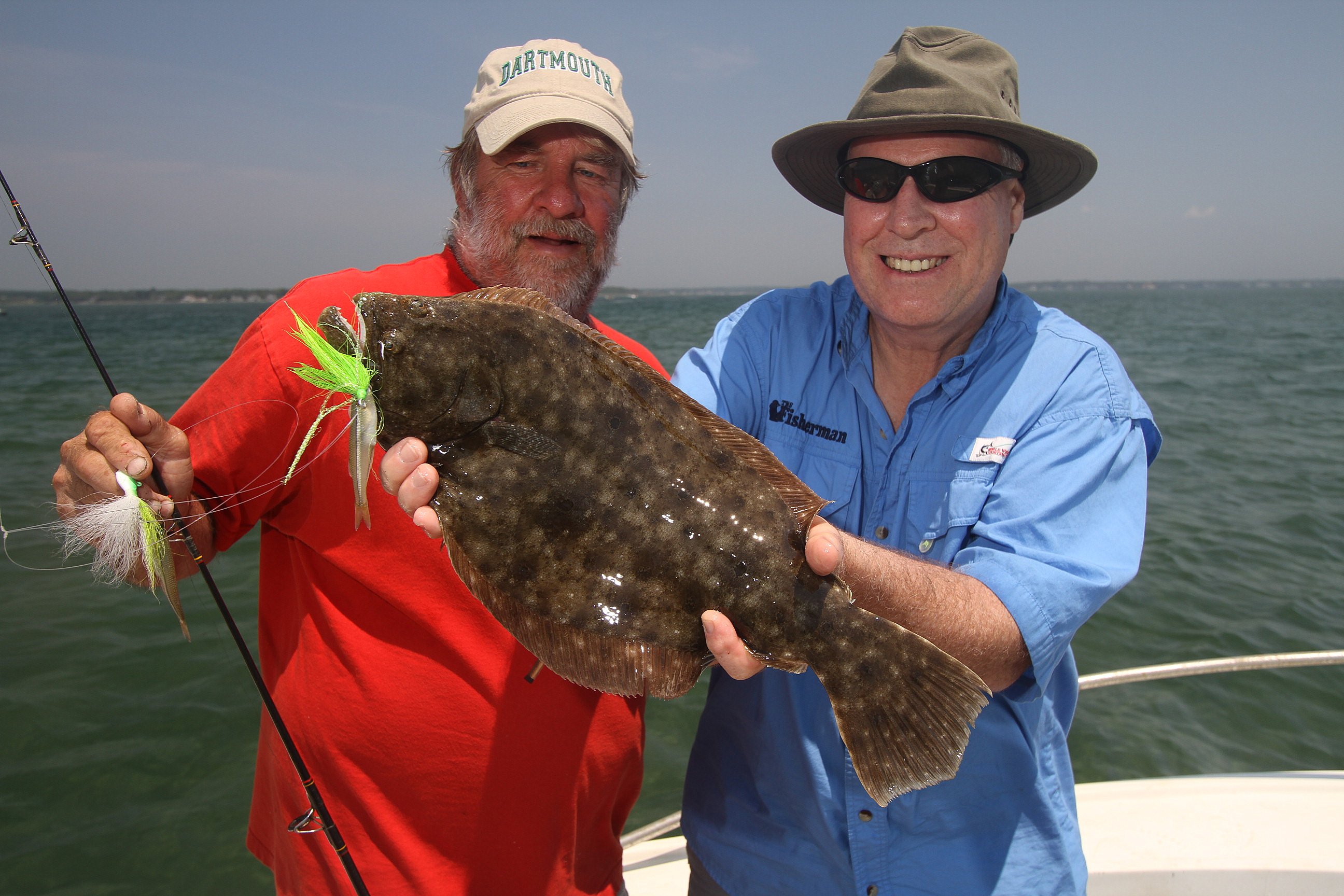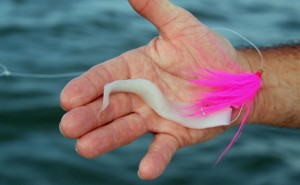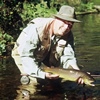FIGURING OUT FLUKE TEASERS, PART 2

Fluke seem to especially favor teasers in shallow water. The author and Gary Grunseich of Silly Lily Fishing Station teased this keeper from the flats of Moriches Bay a while back. Outdoortom.com photo.
Picking up where we left off in part 1, hook size is only part of the equation when teaser size is the topic. Length and fullness of body should also come into play when making your selections. Both factors are relatively easy to choose if you know the type and size of bait present. Long and slender, for example, is a good rule for matching sand eels, with a teaser length of three to five inches about right. To approximate spearing, try something a little shorter; say two to four inches long but with slightly more bulk up front. A cone-head teaser measuring five to six inches works well when squid are in town, while a short, full-bodied pattern in the two- to three-inch class can be used to approximate peanut bunker and young snapper blues.
A TRIO OF TEASER RIGS

A simple white teaser can serve as a control pattern since it works just about everywhere. Having different sizes on-hand allows approximation of a variety of baitfish. Photo by Tom Schlichter.
Generally speaking, I dress three different rigs with fluke teasers. One is the standard high-low style. To tie this rig, attach a 40-inch length of 40-pound test mono leader directly to the main line via a swivel. Use an end loop to secure an appropriate weight bank sinker or fluke ball to the opposite end. Next, tie a small dropper loop six inches above the sinker and secure a 4/0 or 5/0 wide-gap or octopus style lower hook using an 18- to 24-inch length of 30-pound test leader material. Tie a second small dropper loop to attach the teaser roughly 16 inches above the sinker using a 14-inch length of 20-pound test leader material.
This is my favorite rig for ocean and deep water fishing. Let it drop to the bottom and allow between 45 and 60 degrees of line scope to get your teaser in the strike zone. The faster the drift, the greater the scope and the more sinker weight needed. When the fish are finicky, I sometimes replace the bottom hook on this rig with a second teaser.
Another setup that lends itself well to fluke teasers is a high-low bucktail rig. For this, use a swivel to connect a 30-inch length of 20- to 30-lb. monofilament or fluorocarbon leader material to the main line. Tie a fluke bullet or bucktail directly to the end of the leader using a Rapala Loop knot. Add the teaser 12- to 16-inches above the bucktail or bullet using a dropper loop. Over sandy bottom, use a four to six inch loop. In rocky or structure-laden waters, keep the teaser as close to the main line as possible to avoid snagging on the bottom.
This is my favorite shallow water rig for bucktailing fluke, but I’ll sometimes increase the weight of the bottom bucktail or fluke ball to fish as deep as 30 or 40 feet if I’m working with a braided main line. Generally, I work this rig straight up and down, using a lot of bounce and extremely short but sharp line twitches.
Setup number three is my go-to rig when sea robins and skates are obnoxiously present. Use a swivel to connect a 36- to 40-inch length of 20- to 30-pound test leader to the main line and an end loop to connect an appropriate weight bank sinker to the terminal end. Next, tie a 12-inch dropper loop 18 to 24 inches above the sinker. Cut the dropper loop on one side tight to the knot and then attach the teaser to the free end so it rides about 20 inches from the main line.
This rig lets the teaser glide above most robins and skates while remaining in a fluke’s upward slanted field of vision. The rig doesn’t eliminate all of the birds, but it will cut their strikes roughly in half while knocking out most of the skates. The end result is that more fluke get a shot at your teaser. Work this rig with long, slow, sweeping lifts of the rod designed to slide your teaser forward while lifting the sinker only two or three inches from the bottom. Let the line settle and then come tight between each lift.

Hot pink is a teaser color that mid-summer fluke can’t resist. It also accounts for plenty of weakfish in bay-fishing situations. Photo by Tom Schlichter.
SOME FINAL THOUGHTS
A couple of points to note: feather and bucktail teasers take a beating during the season, but fish seem to hold them just a little longer than teasers made of pure synthetics. Thus, look for patterns that incorporate a mix of materials to both withstand a pounding and keep your quarry hanging on long enough for you to set the hook. When the action is fierce, you might also consider using three- to four-inch long soft plastic curly-tailed grubs as teasers. Bring along a pack or two as it’s less expensive than burning through several hand-tied patterns when the sea robins, skates and shorts are grinding up your offerings.
Like I said in the beginning of this article, everyone has their opinions, favorite patterns and rigs when it comes to fluke teasers. Keeping an open mind, experimenting from time to time, and watching how the sharpies set up can go a long way toward increasing your catch. There really are no hard rules when it comes to teasing up summer flatties except to come prepared with an array of choices.
As for my favorite fluke teaser, it’s an olive and white, four-inch Clouser minnow tied with a flash of Mylar on each side. Hands down, I think it is the undisputed heavyweight champ when it comes to tempting doormat fluke on a high hook.
Let the debate begin.
By Tom Schlichter
Use the LIKE button below to get notifications about new articles in your Facebook news feed!



